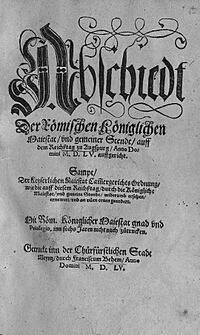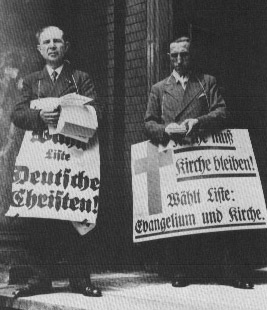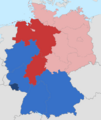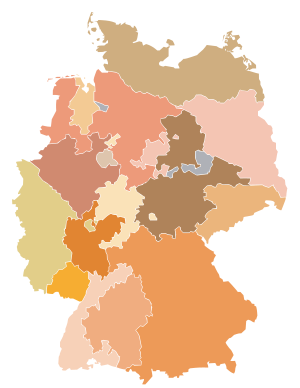Evangelical Church in Germany facts for kids
Quick facts for kids Evangelical Church in Germany |
|
|---|---|
| Evangelische Kirche in Deutschland | |
 |
|
| Type | United church |
| Classification | Protestant |
| Orientation | Lutheran Reformed |
| Polity | Episcopal Presbyterian Congregationalist |
| Chair of the Council | Kirsten Fehrs |
| Associations | World Council of Churches Conference of European Churches Community of Protestant Churches in Europe |
| Region | Germany |
| Origin | 1948 |
| Members | 2024 EKD data: 17.979.849 |
| Other name(s) | The Protestant Church in Germany |
The Evangelical Church in Germany (called EKD for short) is a large community of 20 separate Protestant churches in Germany. These churches include Lutheran, Reformed, and United groups. Together, they represent most of the Protestants in the country.
The EKD is one of the biggest Protestant groups in the world. In 2024, it had about 18 million members. This is more than 21% of the German population. The main offices that manage the EKD are located in Hanover, Germany.
Contents
What's in a Name?
The German word evangelisch means "of the Gospel." The Gospel refers to the teachings of Jesus in the Christian Bible. Martin Luther, a key figure in the Protestant Reformation, liked this term. It showed the importance of the Bible to Protestant beliefs.
In Germany, evangelisch is a broad term for "Protestant." It is different from the word evangelikal, which in German refers to a smaller group known in English as the evangelical movement.
History of the EKD

For a long time, from 1555 until the end of World War I in 1918, many Protestant churches in Germany were state churches. This meant that the ruler of each German state was also the head of the church in that state.
After the war, Germany became the Weimar Republic. The system of state churches ended, and the church and government were separated. Many people wanted to unite all the Protestant churches into one. But this was difficult because each region had its own traditions.
Instead of one big church, they formed a federation. In 1922, 28 regional Protestant churches created the German Evangelical Church Confederation. This was a way for them to work together while staying independent.
A Difficult Time in German History
When Adolf Hitler and the Nazi party came to power in 1933, they tried to control the churches. They wanted to create one unified Protestant church, called the German Evangelical Church, that would support their ideas.
This caused a split. One group, the "German Christians," supported the government. Another group, the Confessing Church, opposed the government's control over religion. They believed the church should follow only the teachings of Jesus.
After World War II ended, German Protestants looked back at this time with regret. In 1945, they issued the Stuttgart Declaration of Guilt. In it, they confessed that they had not done enough to stand up against the terrible things that had happened.
A New Beginning
In 1948, the Protestant churches came together to form the EKD. It was created as a new organization for all German Protestant churches to work together in freedom.
After the war, Germany was divided into West Germany and East Germany. Because of political tensions, the churches in East Germany broke away from the EKD in 1969. They formed their own group. When Germany was reunified in 1990, the East German churches rejoined the EKD in 1991.
How the EKD Works
The EKD is a federation, which means it's a group of independent members working together. The 20 member churches, called Gliedkirchen, have their own rules and leaders. But they all agree on core beliefs and share in worship services.
The EKD has several main governing bodies:
- The Synod is like the church's parliament. It makes important decisions and has members from all the regional churches.
- The Council is the main leadership group. It has 15 members who represent the EKD to the public.
- The Church Conference is where leaders from each member church meet to work on shared goals.
- The Church Office in Hanover handles the day-to-day administration of the EKD.
Women in Leadership
The EKD supports women in leadership roles. Women can be ordained as ministers in all 20 member churches. Many women serve as ministers and bishops. In 2009, Margot Käßmann became the first woman to be the head of the EKD Council.
EKD Members Today
Protestantism is most common in the northern, eastern, and central parts of Germany. In the south, most Christians are Catholic, but some areas are mainly Protestant.
Today, about one in five Germans is a member of an EKD church. However, not everyone attends church services regularly.
The member churches of the EKD respect each other's territories. A church in one region does not open new churches in another region. This way, they work together instead of competing. If a church member moves to a new city, they can easily join the local Protestant church there, no matter if it's Lutheran, Reformed, or United.
Gallery
List of Member Churches
The EKD is made up of 20 regional churches, known as Landeskirchen. Their territories often match the borders of old German states and provinces from long ago.
There are three main types of churches in the EKD:
- 10 United Protestant churches (a mix of Lutheran and Reformed traditions)
- 8 Lutheran churches
- 2 Reformed churches
Here is a list of the member churches:
- Protestant Church of Anhalt
- Protestant Church in Baden
- Evangelical Lutheran Church in Bavaria
- Protestant Church Berlin - Brandenburg - Silesian Upper Lusatia
- Evangelical Lutheran Church in Brunswick
- Protestant Church of Bremen
- Evangelical-Lutheran Church of Hanover
- Protestant Church in Hesse and Nassau
- Protestant Church of Hesse Electorate-Waldeck
- Church of Lippe
- Protestant Church in Central Germany
- Evangelical Lutheran Church in Northern Germany
- Evangelical Lutheran Church in Oldenburg
- Evangelical Church of the Palatinate
- Evangelical Church in the Rhineland
- Evangelical-Lutheran Church of Saxony
- Evangelical Lutheran Church of Schaumburg-Lippe
- Evangelical Church of Westphalia
- Lutheran Church in Württemberg
- Evangelical Reformed Church (a special church with members across different regions)
See also
 In Spanish: Iglesia evangélica en Alemania para niños
In Spanish: Iglesia evangélica en Alemania para niños
- Protestantism in Germany
- Barmen Declaration
- German Protestant Church Assembly










